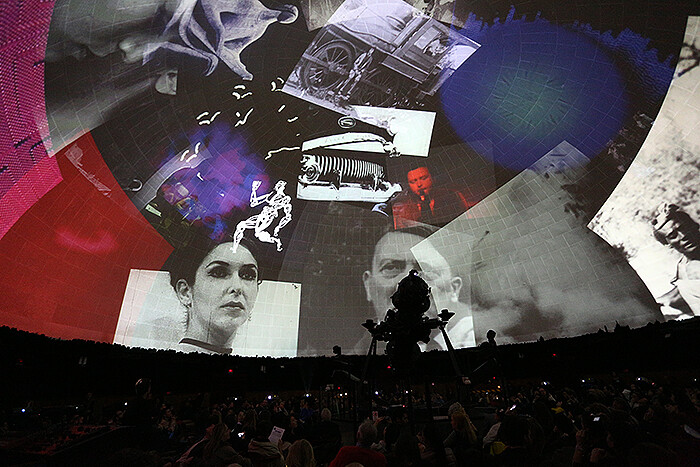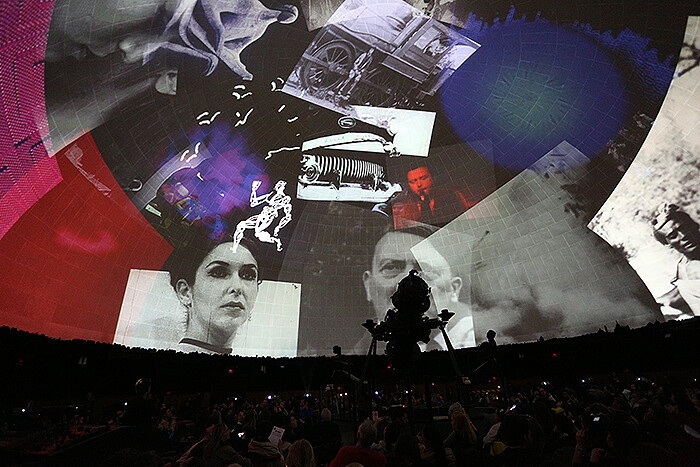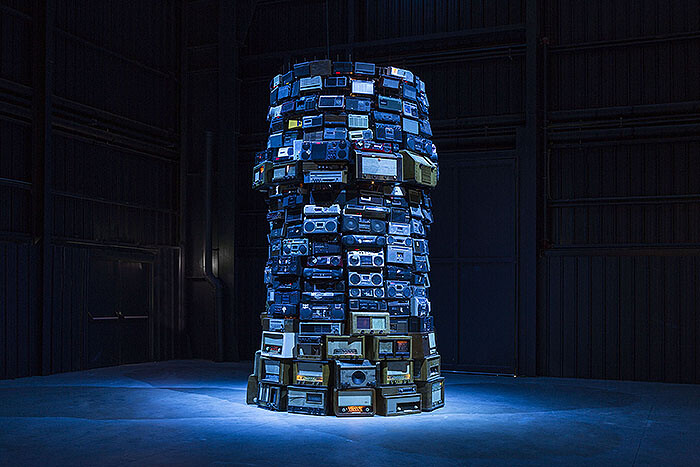March 31, 2014
A spotlight can transform quite a bit with an economy of means, making something instantly visible, no matter how small or familiar. Post-winter sunlight can achieve a similar effect, which is why “The Spring Awakening” was an apt title choice for the program of exhibitions, openings, and performances organized around this year’s miart fair. Although everything under its purview was already on the urban map, miart’s new ventures made the local network of artists, institutions, and galleries look fresher and more energetic, signaling a positive shift within the cultural sphere. Milan’s contemporary art scene seems to be finally catching up with the success of the city’s annual furnishing design bash Salone Internazionale del Mobile, perhaps by emulating its three-part format: a serious fair to busy one’s self for half the day; a range of things to see about town for the other half; and a wide array of social gatherings.
On Friday night at 1 a.m., when I stopped by at the Ulrico Hoepli Planetarium to see Stan VanDerBeek’s Cine Dreams: Future Cinema of The Mind (1972/2014)—an immersive installation of over 50 16mm films and slide projections presented for the first time in its entirety since its premiere—the queue outside was quite long, with sleeping bags and cushions popping out of backpacks. The obvious plan was to spend the night together, looking up at the artist’s collage of frantically moving images as a theater of our inner self. After running around all day to see artworks, my own inner self was in a similar state. Inside, a hypnotized crowd of aficionados and students from Accademia di Belle Arti di Brera and NABA–Nuova Accademia di Belle Arti (Milan’s two art academies, one public, one private) filled the wooden revolving chairs of the octagonal space, a small modernist gem designed by architect Piero Portaluppi in 1930. Over the weekend, the “Cine Dreams” cycle—produced by Fondazione Nicola Trussardi and miart—included two further evenings with Jeronimo Voss’s Eternity Through the Stars (2012) and Katie Paterson’s new work Earth-Moon-Earth (2014).
Another major draw was the opening of Cildo Meireles’s “Installations” retrospective at HangarBicocca, with monumental works from 1969 to 2013. The tiniest of them is Cruzeiro do Sul (1969–70), a 9mm cube made of pine and oak wood, considered sacred by the indigenous Tupí people of Brazil and used by the artist as a personal manifesto of “humiliminimalism”; here, the piece is almost impossible to see, and stands in stark contrast to the Hangar’s oversized dimensions, which begs for ever more spectacular gestures. At Padiglione d’Arte Contemporanea (PAC), Regina José Galindo hit the shock-and-awe button with her Ana Mendieta-inspired videos and performances denouncing the brutality of violence against women.
At the Triennale di Milano there are two solo exhibitions of note. Detroit-born Michael E. Smith took over the huge white cube on the first floor; it is a basilica-like space, even more so now that Daniel Buren’s permanent “in situ” work on its back windows projects yellow, blue, and pink reflections—like medieval stained glass—onto the white floor. Smith left the room empty, choosing instead to hang and install, almost shyly, a series of small sculptures, videos, and paintings on the sidewalls, very low to the ground at child’s height, bringing notions of fragility and protection emotionally into play. In the adjoining room, the cartoons in Ian Cheng’s Metis Suns (2014) endlessly multiply themselves in accordance with infinite machine-dictated variations and morphings. Both shows (the first curated by Simone Menegoi and Alexis Vaillant, the second by Filipa Ramos), which would be difficult to describe as crowd-pleasers, are a reflection of the Triennale’s new artistic direction under Edoardo Bonaspetti, editor of Mousse magazine, an increasingly powerful driving force in town, who teamed up with the fair in order to give it a boost.
Networking turned Via Stilicone, perhaps a bit too bombastically, into “a new art district” with simultaneous openings: Galleria Lia Rumma presented three historical works by David Lamelas that were updated for the occasion. Across the street, the Battaglia Fine Art Foundry (a must-see itself, with Giuseppe Penone’s gigantic bronze trees perennially occupying the courtyard) hosted Cathy Wilkes’s installation Sea of Galilee (2009) downstairs, while on the first floor, Peep-Hole (a space co-founded and run by Vincenzo De Bellis, miart’s artistic director, bringing the fair’s collateral events full circle) presented Uri Aran’s site-specific Puddles (2014), a long table cutting across three rooms, which asks the viewers to choose sides and to play and invent new rules, while watching videos that Aran describes as “sometimes happy, sometimes sad,” a sentiment in perfect harmony with the ups and downs of spring’s fluctuating moods. Nearby at long-standing non-profit space Careof DOCVA, Ludovica Carbotta asked a number of friends to send her descriptions of ideal spaces for community life, and built A motorway is a very strong wind (2014), a series of DIY sculptures in response to the texts.
Overall, the presence of Italian artists on the radar was quite small. Berlin-based Patrick Tuttofuoco presented his last “Ambaradan” (2014) series of giant heads made of textiles and resin in three locations: Studio Guenzani, Ermanno Previdi’s architectural studio, and, in order to facilitate unfiltered chance encounters, a McDonald’s restaurant located in the central Piazza Duomo. The heads pay homage to the Casa degli Omenoni (which means “House of Big Men” in the local dialect), a Mannerist Milanese palazzo whose façade is decorated with giant protruding atlantes. At Galleria Raffaella Cortese, Vienna-based Michael Fliri held Returning from places I’ve never been, a theatrical, one-night performance, while Paolo Chiasera and Flavio Favelli initiated a painting/sculpture conversation at Francesca Minini. By far, the main Italian contribution to the weekend’s events was the opening of Palazzo Reale’s “Piero Manzoni. 1933–1963” exhibition, where everybody can pick up their very own inexpensive, museum-shop trinket of Merda d’artista [Artist’s Shit] (an edition of the original, infamous work from 1961). With 126 works, it’s a rich overview of Manzoni’s career, but it seems to isolate him from the Milanese network from which he arose, and to sanctify forms over attitudes, which were so often performative, playful, and subversive in his work. Fortuitously, “The Spring Awakening” also included the public opening of the studio of Manzoni’s close friend and outsider figure Vincenzo Agnetti, which will continue to be on permanent display; the presentation includes several language-based conceptual works, like the wonderful Macchina drogata [Drugged Machine] (1967/68).
Painting (with a good deal of self-inflicted parody) was another thread in the gallery shows, with blue-chip venues like Massimo De Carlo and Gió Marconi opting for the work of Josh Smith and Amelie Von Wulffen, respectively. Still looking for a new location, Galleria ZERO… temporarily squatted a construction site at Piazza Vesuvio with a group show titled “Imitatio Christie’s (partoftheprocess6),” which includes Catharine Ahearn’s soap paintings, Mark Barrow’s geometric abstractions, and Ylva Ogland’s expanded paintings depicting heroin paraphernalia and wisdom teeth. Pae White’s Lucky Charms (2014), a light installation at Kaufmann Repetto, provided an invigorating therapy of illumination and warmth, as well as a perceptual challenge: each of its hundreds of neon tubes emits a subtly different shade of white light. A wave of New York up-to-dateness could be found at Gasconade, with Dena Yago reflecting upon the seasonality of local art scenes, and at Fluxia, with Andrew Norman Wilson’s deadpan Uncertainty Seminars (2014), a series of videos presented in collaboration with artist Nick Bastis.
At Lisson Gallery, Ceal Floyer’s Greener Grass (2014), a patch of artificially colored grass that looks much, much brighter than real life, is installed outside in a beautiful enclosed garden overlooking the gallery. It feels like a subtle warning. The spotlight effect has its downside, too; it fictionalizes its subject and casts everything beyond its luminous cone into shadow. In the city of Milan, critical problems like the absence of a contemporary art museum, the weakness of the existing institutions, and the precarity of non-profit spaces reflect the effects of the larger economic crisis. In light of this, the overwhelming heft of the private sector will simply grow: in 2015, Fondazione Prada will open its new Rem Koolhaas-designed exhibition spaces, and EXPO Milano 2015 is already constructing its new sites for the upcoming universal exhibition all over the city. More spotlights coming soon.













